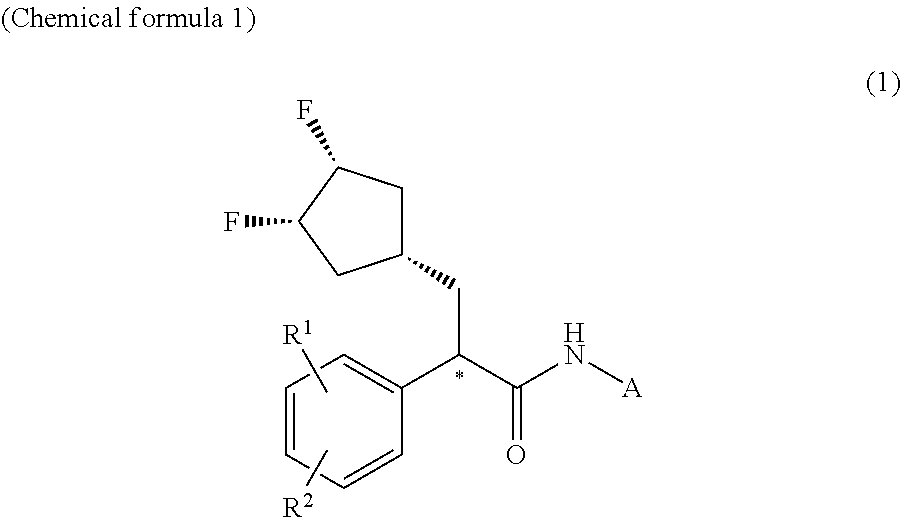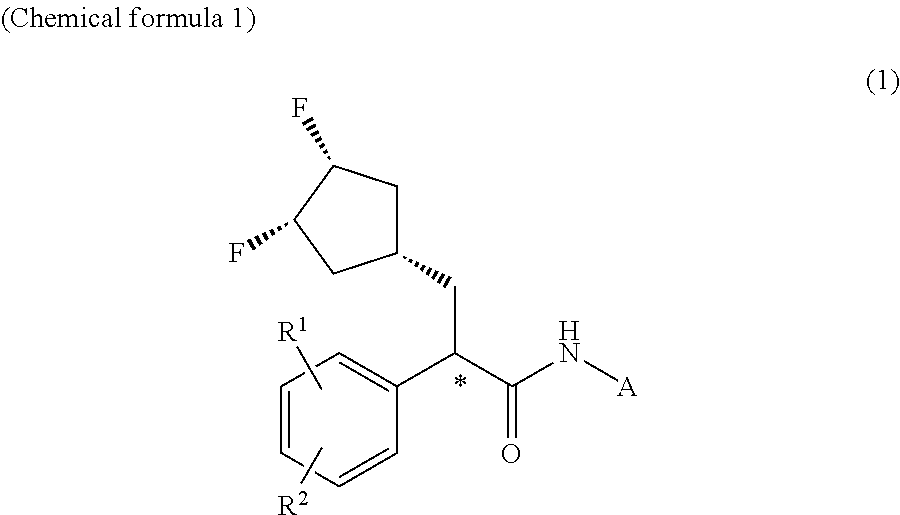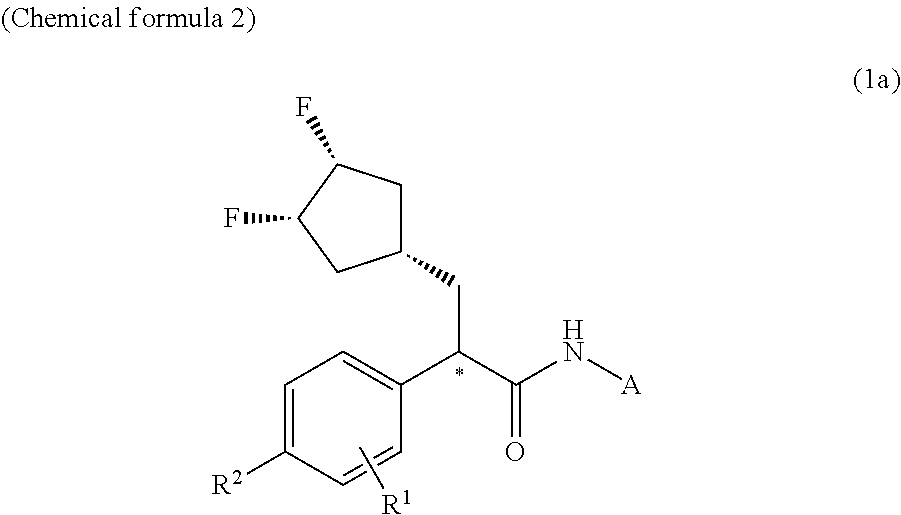Glucokinase activator
a technology of glucokinase and activator, which is applied in the field of activators of glucokinase, can solve the problems of increasing the number of patients suffering from insulin resistance and the predominance of defective insulin secretion, and achieves the effects of prolonging the qt interval and hypoglycemia, and fewer side effects
- Summary
- Abstract
- Description
- Claims
- Application Information
AI Technical Summary
Benefits of technology
Problems solved by technology
Method used
Image
Examples
example 1
(±)-3-[(1α,3α,4α)-3,4-difluorocyclopentyl]-2-(4-(methylsulfonyl)phenyl)propionic acid
[0075]
[0076]To a tetrahydrofuran solution (20 mL) of lithium diisopropylamide (10.2 mmol) containing N,N-dimethylpropyleneurea (3.92 mL), a solution of 4-methylsulfonylphenyl acetic acid (1.04 g) in tetrahydrofuran (7 mL) was added dropwise at −78° C. The mixture was stirred for 2 hours at −45 to −30° C. Subsequently, (1α,3α,4α)-3,4-difluorocyclopentylmethyl iodide (1.20 g) was added dropwise at −78° C. and the mixture was allowed to gradually warm to room temperature under stirring. Water (15 mL) was then added and tetrahydrofuran was evaporated under reduced pressure. To the resulting residue, 6 mol / L hydrochloric acid was added to a pH of 2. The mixture was then extracted with ethyl acetate and the organic layer was dried over anhydrous sodium sulfate, filtered and concentrated. Purification of the resulting residue by silica gel column chromatography afforded (±)-3-[(1α,3α,4α)-3,4-difluorocyclo...
example 2
(4R)-4-benzyl-3-[3-[(1α,3α,4α)-3,4-difluorocyclopentyl]-2-(4-(methylsulfonyl)phenyl)propanoyl]oxazolidine-2-one
[0079]
[0080]Triethylamine (975 mL) was added to a solution of (±)-3-[(1α,3α,4α)-3,4-difluorocyclopentyl]-2-(4-(methylsulfonyl)phenyl)propionic acid (931 mg) in tetrahydrofuran (12 mL). While the mixture was cooled in a salt-ice bath, pivaloyl chloride (362 mL) was added dropwise and the mixture was stirred for 1 hour. Subsequently, (R)-4-benzyloxazolidinone (494 mg) and lithium chloride (130 mg) were added and the mixture was further stirred at room temperature for 4 hours. The insoluble material was removed by filtration and the filtrate was concentrated. The resulting residue was dissolved in ethyl acetate. The solution was washed sequentially with a saturated aqueous sodium bicarbonate solution and a saturated sodium chloride solution, dried over anhydrous sodium sulfate, filtered and concentrated. Purification of the resulting residue by silica gel column chromatography...
example 3
(−)-3-[(1α,3α,4α)-3,4-difluorocyclopentyl]-2-(4-(methylsulfonyl)phenyl)propionic acid
[0087]
[0088]To a tetrahydrofuran solution (5 mL) of isomer A of (4R)-4-benzyl-3-[3-[(1α,3α,4αα)-3,4-difluorocyclopentyl]-2-(4-(methylsulfonyl)phenyl)propanoyl]oxazolidine-2-one (250 mg), an aqueous solution (1.3 mL) of lithium hydroxide (24.0 mg) containing 30% hydrogen peroxide solution (206 μL) was added under cooling with ice. The mixture was stirred for 1 hour. Subsequently, a 1 mol / L aqueous sodium sulfite solution and a saturated aqueous sodium bicarbonate solution were added and the mixture was washed with ethyl acetate. 1 mol / L hydrochloric acid was added to the aqueous layer to pH 2 and the aqueous layer was extracted with ethyl acetate. The organic layer was washed with saturated sodium chloride solution, dried over anhydrous sodium sulfate, filtered and concentrated. The resulting residue was washed with diethyl ether to afford (−)-3-[(1α,3α,4α)-3,4-difluorocyclopentyl]-2-(4-(methylsulfo...
PUM
| Property | Measurement | Unit |
|---|---|---|
| temperature | aaaaa | aaaaa |
| temperature | aaaaa | aaaaa |
| pH | aaaaa | aaaaa |
Abstract
Description
Claims
Application Information
 Login to View More
Login to View More - R&D
- Intellectual Property
- Life Sciences
- Materials
- Tech Scout
- Unparalleled Data Quality
- Higher Quality Content
- 60% Fewer Hallucinations
Browse by: Latest US Patents, China's latest patents, Technical Efficacy Thesaurus, Application Domain, Technology Topic, Popular Technical Reports.
© 2025 PatSnap. All rights reserved.Legal|Privacy policy|Modern Slavery Act Transparency Statement|Sitemap|About US| Contact US: help@patsnap.com



